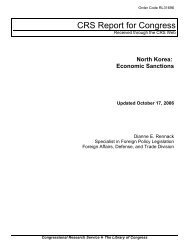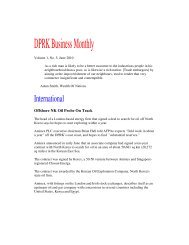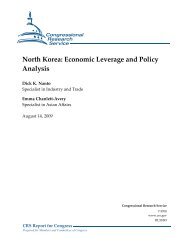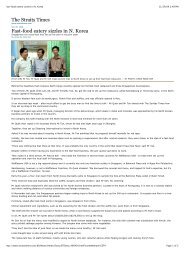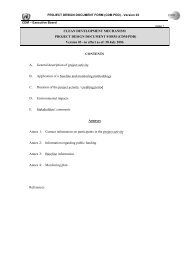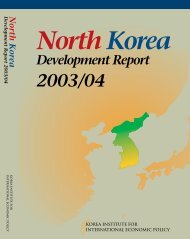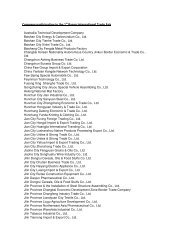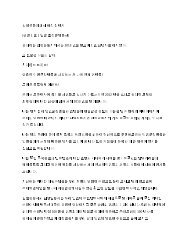North Korean Policy Elites - Defense Technical Information Center
North Korean Policy Elites - Defense Technical Information Center
North Korean Policy Elites - Defense Technical Information Center
You also want an ePaper? Increase the reach of your titles
YUMPU automatically turns print PDFs into web optimized ePapers that Google loves.
Society is divided into three broad groups delineated by Kim Il-sung: core, wavering, and hostile.<br />
Each of these is, in turn, divided into a total of 51 sub-groups, based on pre-liberation (from<br />
Japanese occupation) family status. Social mobility is rare.<br />
Members of the core group carry out Kim Jong-il’s orders, run the state apparatus, and<br />
perform other functions deemed necessary to the state. These people comprise an elite in the<br />
sense that they occupy the most important positions and have power over certain situations and<br />
people. They are rewarded with housing, medical care, education, and goods unavailable to<br />
ordinary citizens. However, just as <strong>North</strong> Korea is a leader-dominant society like no other, its<br />
elite is like no other because its status and power are entirely derived from the Kims.<br />
Revolutions in other countries have, to be sure, jumbled societies, purging traditional<br />
elites and catapulting lower or marginalized groups to the fore. But no matter how a society is<br />
recast, one would expect to find at least some elites come to the table with power derived from a<br />
variety of power bases - military, labor, religious, regional, ethnic, linguistic, business, academic,<br />
etc. In <strong>North</strong> Korea, Kim Jong-il bestows power, status, and perquisites. The organizational chart<br />
of the upper strata of <strong>North</strong> <strong>Korean</strong> society would resemble spokes on a bicycle wheel with no<br />
rim and no tire. Those closer to Kim Jong-il - the hub - rank higher than those farther out, with<br />
no connection among the spokes, except at the hub.<br />
These people did not achieve their positions without making personal calculations. They<br />
must have likes and dislikes, and some of them may not like Kim Jong-il. As Oh and Hassig<br />
explain, “the greatest threat to the security of the Kim regime would come from a palace coup by<br />
top cadres or by the security people.” 12 Kim Jong-il knows this and guards against it. A former<br />
bodyguard recounts that when the Dear Leader visits Peoples’ Army units, soldiers must unload<br />
their weapons, air activity in the vicinity is prohibited, and his personal bodyguards keep even<br />
security agents 1,000 meters away. 13 Sin Sang-ok suggests that when the Dear Leader traveled to<br />
Moscow, he “took about 150 people with him on the train because they were the people likely to<br />
revolt during his absence.” 14<br />
However, knowing that there must be discontent, and finding it, are different things.<br />
Forming even the loosest of associations would require articulating discontent, a crime one<br />
commits only once in <strong>North</strong> Korea. Therefore, there are no independent groups in <strong>North</strong> <strong>Korean</strong><br />
society, certainly none based on dissension among the elite. Consequently, it is more accurate to<br />
12 Oh & Hassig, p. 38. For a good analysis of the <strong>North</strong> <strong>Korean</strong> social structure and political control, see Chapter<br />
Six, pp. 127-147.<br />
13 “DPRK Leader’s Former Bodyguard Describes Security Procedures on Inspection Tours,” Seoul Nanun Kim<br />
Chong-il Kyonghowoniotta, p. 5, November 20, 2002, FBIS translation KPP20030124000045.<br />
14 Sin Sang-ok.<br />
V-4



